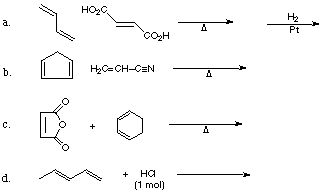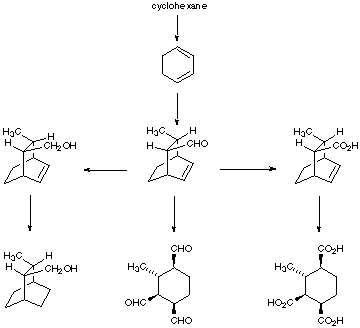![]()
![]()
1. Give the products of the following reactions:

2. Give the reagents or products as appropriate for the following synthetic sequences:

3. Specify the reagents, reactants and conditions you would use to carry out the following synthetic sequence.

4. Draw the MOs for 1,3-butadiene. Show how the energies of these MOs are affected by including a 1,4 interaction as shown below.
![]()
5. Consider a variant of the SN2 reaction which proceeds with retention of configuration. Use molecular orbital theory to determine the feasibility of frontside attack of a C-X bond by a nonbonding orbital of a nucleophile as shown below.

a. Place the relevant molecular orbital(s) (MOs) of the C-X sigma bond on the left side of the paper and the orbital of the nucleophile on the right. Construct the molecular orbitals for the above interaction in between. The nodal properties (i.e., symmetry) and the relative energies of all of the orbitals should be clearly illustrated.
b. Determine whether this interaction of a nucleophile and
C-X bond is energetically favorable or not. What is your prediction
about the feasibility of this reaction?
c. Consider now the reaction between an electrophile and the C-X bond using your diagram. Determine if this interaction is energetically favorable or not. What is your prediction about the feasibility of this reaction?
Materials adapted from:
Peer-Led Team Learning: Organic Chemistry, 1/e
Jack A. Kampmeier, University of Rochester
Pratibha Varma-Nelson, St. Xavier University
Donald Wedegaertner, University of the Pacific
Prentice-Hall, 2001, ISBN 0-13-028413-0
http://www.sci.ccny.cuny.edu/~chemwksp/OrganicChem.html